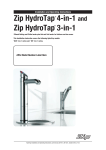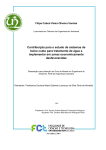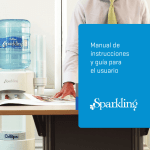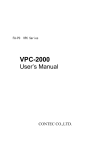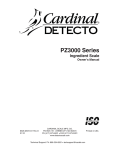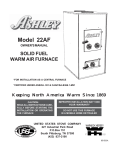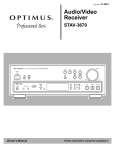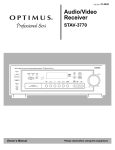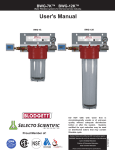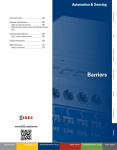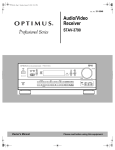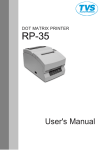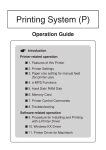Download OASIS® Watercooler Service Training Manual
Transcript
OASIS® Watercooler Service Training Manual Contents Chapter 1: Introduction 1.1 Chapter 2: General Care of the Removable Reservoir Cooler 2.1 Caring for your water cooler Sanitising your water cooler Setting up the water cooler at your premises Installing the water cooler at your customer’s premises 2.1 2.1 2.2 2.3 Chapter 3: Troubleshooting 3.1 Chapter 4: Easy Solutions 4.1 Checking the Voltage Received by the Cooler Matching the Customer’s Needs with the Cooler’s Capacity Cleaning the Bottle Cooler’s Hot Tank 4.1 4.1 4.2 Testing and Repairing Cooler Parts 5.1 Safety Precautions Access to Parts Inside the Cooler Airbell Baffle Capillary Line and Strainer Cold Control Compressor Condenser Faucets and Gaskets Hot Tank and its Components Hot Tank Switch Hot Tank Vent Hole Overload Refrigerant Relays Removable Reservoir Service Cord Tubing Water Bottle WaterGuard Wires, Terminals and Connectors 5.1 5.1 5.2 5.2 5.2 5.3 5.4 5.4 5.4 5.14 5.14 5.14 5.14 5.14 5.15 5.15 5.16 5.16 5.17 5.17 Chapter 5: Appendix A: Basic Refrigeration Cycle Components of a Basic Refrigeration System How the Components Work Together to Form a Refrigeration Cycle Appendix B: Exploded Parts Breakdown of OASIS® Bottle Coolers A.1 A.2 B.1 Diagrams: Fig 1A Fig 1B Fig 2 Fig 3A Fig 3B Fig 3C Fig 3D Fig 4 Fig 5 Fig 6A Fig 6B Fig 7 Fig 8A Fig 8B Fig 9 Removable reservoir Removable reservoir Location of the cold control HT1 Hot tank – Fixed temperature hot control HT1 Hot tank – Adjustable hot control HT2 Hot tank – Floor Standing Cooler HT2 Hot tank – Countertop Cooler Hot tank vent hole Location of compressor relay Start relay (cold) Start relay (hot) Electrical circuit diagrams WaterGuard® III assembly WaterGuard® IV assembly Basic refrigeration system OASIS Corporation Introduction Chapter 1 Introduction OASIS Manufacturing Company, founded in 1910 in Columbus, Ohio as the D.A. Ebinger Sanitary Manufacturing Company, manufactures water coolers for distribution world-wide. OASIS® products, including the OASIS® brand coolers, are supported by more than 400 authorised service centres. OASIS® quality is a result of rigid standards for raw materials, precision tooling, efficient manufacturing methods, and extensive testing of all subassemblies and completed units. OASIS’s distributors maintain a high level of customer service. This manual is intended for use in OASIS® service training and for reference. It presents aids to troubleshooting problems, testing and repair instructions, and basic information about refrigeration cycles. Diagrams and schematics of standard models of OASIS® coolers are provided as examples. The primary emphasis of this manual is the Removable Reservoir range of bottle water coolers. Although the function of the compressor and possible symptoms indicating the need for its replacement are discussed in this manual, no compressor replacement instructions are included inside. Replacement of compressors must be handled by a fully qualified refrigeration repairman. If you are unfamiliar with how a basic refrigeration cycle works or with standard OASIS® bottle coolers, begin by referring to the following appendices: A B Basic Refrigeration Cycle Exploded Parts Breakdown of OASIS® Bottle Cooler 1-1 OASIS Corporation Cooler General Care of the Removable Reservoir Chapter 2 General Care of the Removable Reservoir Cooler Caring for your water cooler 1. 2. 3. 4. 5. 6. 7. 8. 9. 10. 11. 12. 13. 14. 15. 16. Do not locate your cooler where the environment would offer any risk of water contamination. The cooler must be located on a floor which is smooth, level and easily cleaned. Do not locate the cooler in direct sunlight. Do not locate the cooler next to a radiator. Do not locate the cooler within or directly adjacent to toilet facilities. Do not use the cooler or water bottle as a shelf for plants or objects. Do not use sprays, mists or vapours around the water cooler. Do not put any other liquid other than water into the cooler. Do not touch the nozzles of the faucets. Do not take water from the faucets if your hands are dirty. Do not lay the cooler on its side. Do not leave the cooler without a bottle fitted. Do not attempt to move the cooler if there is a bottle in place. When properly installed the water cooler is electrically safe. Even so, do not locate the cooler in constantly damp areas, beneath dripping pipes, or where water may collect underfoot. Keep areas around the water cooler free from dirt and rubbish. The plastic cabinetry should be cleaned using mild soap and water. Do NOT use bleach or any cleaning agents containing bleach or chlorine. Sanitising your Water Cooler Recommended Materials • Disposable gloves • One time use wipes • Mild cleaning agent for outside of cabinet and drip receptor: The following cleaners are acceptable : Mild soap and water Fairy Liquid Fantastik DO NOT use bleach or any cleaning agents containing bleach or chlorine. • Chlorine test kit 2-1 OASIS Corporation Cooler General Care of the Removable Reservoir Sanitisation Procedure 1. 2. 3. 4. 5. 6. 7. 8. 9. 10. 11. 12. 13. 14. 15. 16. 17. 18. 19. 20. 21. 22. 23. 24. 25. 26. Disconnect the power supply from the cooler Remove the bottle from the reservoir Drain water from the reservoir and hot tank (if fitted) through the faucets Remove the WaterGuard® Remove the faucets Disassemble the WaterGuard® and discard the air filter Remove the baffle Remove the reservoir Wash hands thoroughly Put on disposable gloves Wash the faucets, WaterGuard® components, baffle and reservoir using mild soap and water. Rinse with clean water immediately. Clean the faucets, WaterGuard® components, baffle and reservoir using the sanitising solution. Parts MUST be completely submerged in the solution Rinse with clean water immediately Reassemble the water cooler using the sanitised components Sanitise hot tank (if fitted) and entire cooler with a new batch of sanitising solution. Completely fill the cooler with sanitising solution, and let stand for 5 minutes. Drain solution through hot tank drain tube (if fitted), or through faucets. Rinse with clean water immediately. Invert a water bottle on top of the cooler Flush the reservoir at least three times to remove any traces of the sanitisation material Use chlorine test kit to identify the presence of any contaminants If contamination still exists, repeat steps 21 and 22. Fit the new air filter to the Waterguard®. Clean the outside of the cabinet and the drip tray using a mild cleaning agent Reconnect the power supply to the cooler Setting up the water cooler at your premises 1. Examine the packaging for signs of damage – report any damage to the haulier. 2. Remove the carton from the cooler – lie the cooler on its side, cut open the tape sealing the bottom flaps of the carton and replace the cooler in the upright position. Lift the carton from the cooler. 3. Remove the shipping bag from the cooler. 4. Carry out a general inspection of the cooler, ensuring that: a) b) c) d) e) f) g) There are no marks or physical damage to the cooler. That all accessories are present. That the faucets are tight and in an upright position. That all the wires and electrical connections are in place at the back of the cooler. That the cold control is set to the maximum cold position. That the hot tank switch is in the “OFF” position. That the cooler is clean and dust free. 2-2 OASIS Corporation Cooler General Care of the Removable Reservoir 5. Sanitise the water cooler. 6. Replace the shipping bag over the water cooler. 7. Replace the carton over the top of the cooler. 8. The cooler is now ready for transportation to the customer’s premises. Installing the water cooler at your customer’s premises 1. Carry the cooler in the upright position to the customer’s premises - use the handle at the rear of the unit. DO NOT LIFT THE UNIT BY THE FAUCETS. 2. At the customer’s premises, ensure that there are no marks or visible damage to the carton. 3. Remove the cooler from the carton. 4. Remove the shipping bag from the cooler. 5. Carry out a general inspection of the cooler, ensuring that: a) b) c) d) e) f) g) There are no marks or physical damage to the cooler. That all accessories are present. That the faucets are tight and in an upright position. That all the wires and electrical connections are in place at the back of the cooler. That the cold control is set to the maximum cold position. That the hot tank switch is in the “OFF” position. That the cooler is clean and dust free. 6. Place a bottle of water on top of the unit. As soon as the bottle is in place, ensure that the hot faucet is pressed open and the appropriate time is allowed until the hot tank is full – i.e. water flows out of the hot faucet and air stops going back into the bottle. 7. Check that water flows through the cold faucet. 8. Connect the unit to the electricity supply using the power cord. 9. Switch on the hot tank and allow the unit to operate for 25 minutes. 10. Using a flash light, check through the back of the cooler for water leaks. 11. After the unit has operated for 25 minutes, check that there is hot water from the hot faucet and cold water from the cold faucet. 12. Recheck the cooler for water leaks. 13. Ensure that the cooler is in the customer’s desired location, and that all the accessories are attached to the water cooler. 2-3 OASIS Corporation Troubleshooting Chapter 3 Troubleshooting Discovering the source of a problem is sometimes more difficult and time-consuming than actually resolving the problem. Chapter 3 presents a troubleshooting chart to help you diagnose problems with OASIS® bottle coolers. There are two types of problems you may be called upon to correct: 1. Something is wrong with the cooler. Parts need to be set up correctly, repaired, or replaced. 2. Nothing is wrong with the cooler. The cooler is not getting power or it is receiving power at the wrong voltage, the cooler is being expected to perform beyond its capability, or the cooler simply needs to be cleaned. The troubleshooting chart lists common symptoms (such as “water too cold or frozen”) and the conditions or parts that may be causing the symptoms. Refer to Chapter 5, Testing and Repairing Cooler Parts, for instructions on testing, repairing, and replacing specific parts that may be causing the problem. Chapter 4, Easy Solutions, discusses three remedies for common problems that do not require repair work (power source, capacity, and cleaning). 3-1 OASIS Corporation Troubleshooting Troubleshooting Chart for Bottle Coolers Symptom Solution Checklist Page No cold water and compressor not running 1. Check voltage received by cooler 2. Check cold control 3. Check wires 4. Check compressor relay 5. Check compressor overload 6. Check compressor 4.1 5.3 5.21 5.19 5.18 5.4 No cold water and compressor running 1. Check voltage received by cooler 2. Check for a refrigerant leak 3. Check for a restriction in capillary line or strainer 4. Check compressor 4.1 5.18 5.2 Water too cold or frozen 1. Check cold control 2. Check for a refrigerant leak 5.3 5.18 Unit runs noisily 1. Check for vibrations caused by loose screws 2. Check for vibrations at refrigeration lines 3. Check compressor 5.4 No hot water 1. Is switch for hot tank turned off? 2. Check voltage received by cooler 3. Check heat limiter 4. Check hot control 5. Check wires 6. Check hot tank heating element 5.17 4.1 5.5 5.5 5.21 5.5 No water flow from hot faucet 1. Is water bottle empty? 2. Check hot faucet 3. Check for mineral build-up in hot tank 5.5 4.2 3-2 5.4 OASIS Corporation Troubleshooting Troubleshooting Chart for Bottle Coolers (continued) Symptom Solution Checklist Page Hot water too hot or boiling over 1. Has tank been bled of air 2. Check hot control 3. Check for mineral build-up in hot tank 4. Check for plugged hot tank vent hole 2.2 5.5 4.2 5.17 Water leaks 1. Check for cracked plastic bottle 2. Check for damaged reservoir 3. Check for loose faucet or damaged gasket 4. Check hot tank inlet seal 5. Check hot faucet fitting 6. Check hot tank drain fittings 7. Check hot tank for damage 5.21 5.19 5.5 5.5 5.5 5.5 5.5 Oil on refrigerant lines 1. Unplug service cord 2. Contact refrigeration repairman 3-3 OASIS Corporation Easy Solutions Chapter 4 Easy Solutions Some problems have simple solutions. This chapter describes three cases in which a cooler is not meeting a customer’s needs, but nothing is wrong with the cooler. In the first case, the cooler is not receiving the correct voltage. In the second case, the capacity of the cooler is inadequate for the customer’s requirements, and in the third case, the cooler simply needs to be cleaned. Checking the Voltage Received By the Cooler The easiest solution to a non-working cooler may be to plug the cooler’s service cord into an electrical outlet. Although most solutions are not usually this simple to find, do not be lulled into forgetting to check this possible cause of trouble. Check • • Is the service cord plugged in? Is the switch controlling the outlet in the OFF position? Test 1. Plug in the cooler. 2. Make sure any switch controlling the outlet is in the ON position. Remove the service cord from the wall outlet and plug in a portable radio or similar device. If the radio works, the outlet is good. Repair / Solution Incorrect voltage through the outlet may need to be corrected by the local utility company. Contacting the utility is the responsibility of the customer. Matching the Customer’s Needs with the Cooler’s Capacity Under normal conditions, most bottle coolers will produce 4.5 litres of cold water (< 10ºC) per hour and a little more than nine litres of hot water (80º - 90ºC) per hour. Check • • • Room temperature. If the temperature of the room containing the cooler or the temperature of the water in the cooler’s water bottle is above 32ºC, the cooler will not be able to provide as much cold water within the standard amount of time. Amount of hot/cold water required in an average hour. Find out how many persons use the cooler each hour and what size cups they are filling. Calculate the total amount of water required in an average hour. Special customer needs for large amounts of water during certain periods of the day. For example, does the customer need nine litres of cold water at 12.45 each afternoon to fill pitchers for meeting rooms? Does the customer need eighteen litres of hot water early each day when coffee or tea is prepared? Repair/ Solution If a customer’s demands are exceeding the cooler’s capabilities, suggest adding another cooler. 4-1 OASIS Corporation Easy Solutions Cleaning the Bottle Cooler’s Hot Tank The use of some types of water may eventually cause a build-up of mineral deposits on the inside of the hot tank. These mineral deposits insulate the water in the tank from the hot control and prevent the hot control from sensing the hot water temperature. Bottle water coolers need to be cleaned periodically to prevent this mineral build-up inside the heating tank. The frequency of cleaning is determined by the quantity of minerals in the bottle water and the amount of water used. Heating tanks may require cleaning when: 1. Normal hot water flow appears restricted. 2. Noisy heating cycles are heard. 3. Water in the cooling tank is very warm. 4. Mineral build-up has imparted a taste to the water. Offer your customers hot tank cleaning whenever a cooler must be brought in for repairs. Even though mineral buildup and corrosion are not covered under OASIS warranties, many customers will want this preventive maintenance, which will extend the life of the cooler. Instructions for cleaning the hot tank are listed on the following pages. Recommended Materials • • • • Hot Tank de-scaling solution : Dissolve 125 grams of citric acid crystals in 1 litre of hot water Bucket or pan with 8 - 10 litre capacity Funnel with 8mm diameter end Rubber gloves Repair/ Solution 1. 2. 3. 4. 5. 6. 7. 8. 9. 10. 11. 12. 13. Disconnect the power supply cord. Draw water from the hot faucet until the water is cool. Remove the bottle from the unit. CAUTION: A nearly full bottle of water weighs over forty pounds ( 18.1 kg ) and can be awkward to handle. It may be necessary for you to drain water from the bottle until it becomes manageable. Drain water from the reservoir through the cold faucet. Place a bucket or pan under the black drain valve located at the rear of the cooler. Turn the valve’s petcock counter clockwise to open. CAUTION: HOT WATER CAN SCALD HANDS. Turn the drain valve to a closed position when the tank is empty. For easy access to the hot tank inlet tube, remove the reservoir by unscrewing the cold faucet ( blue handle ) and pulling upward on the reservoir’s lip. Remove the baffle from the reservoir. Place a funnel with an 8 mm diameter end into the supply tube. Mix 125 grams of citric acid crystals with one litre of very hot water. ( wearing rubber gloves is recommended ) Carefully pour the hot solution into the funnel. BE CAREFUL NOT TO SCALD YOUR HANDS. Replace the removable reservoir and the cold faucet. 4-2 OASIS Corporation 14. 15. 16. 17. 18. 19. 20. 21. 22. 23. 24. 25. Easy Solutions Fill the reservoir with bottled water until the water level is 75 mm from the top. To allow the hot tank to fill, open the hot faucet until the water begins to flow, then close the faucet. Plug the service cord into the wall socket. Let the unit stand for at least twenty minutes. While the citric acid solution is cleaning the hot tank, this is a good time to clean the rest of the unit. Inspect the back of the unit for lint or dirt on the wire and tube condenser. If it is dirty, clean it with a non-wire stiff brush or a vacuum cleaner. Unplug the service cord. Using rubber gloves and taking care not to scald your hands, draw water from the hot faucet until the flow ceases. Open the heating tank drain, catching the water in a pan or bucket. The water will be discoloured. This drain water should be immediately poured down a drain to prevent accidental spilling; this water will stain. Pour at least 4.5 litres of bottled water into the cooling reservoir and allow this water to drain from the heating tank drain. Drain any remaining water in the reservoir through the cold faucet. Turn the drain valve to a closed position when the hot tank is empty. Replace the baffle and place a bottle of water on the unit. Open the hot faucet to allow the tank to fill. Plug the service cord back into the wall socket. After the unit has run for ten to fifteen minutes, draw at least one litre of water from both hot and cold faucets. Your heating tank should now be clean. If the flow of water or the noisy cycles have not been improved, you should have the unit repaired at an authorised service centre. Cleaning the unit in this manner will not only make the unit run more efficiently, but will make the water taste better. 4-3 OASIS Corporation Parts Testing & Repairing Cooler Chapter 5 Testing and Repairing Cooler Parts Chapter 5 provides detailed instructions on how to inspect, test, repair, and replace the OASIS® cooler parts you will most frequently be required to service. Use the troubleshooting chart provided in Chapter 3 to diagnose potential problems, then refer to this chapter for specific information about each part mentioned in the troubleshooting chart. OASIS® cooler parts are organised alphabetically in this chapter. Review the following safety precautions before beginning service on any cooler. Safety Precautions 1. ALWAYS UNPLUG THE COOLER BEFORE WORKING ON IT. The water coolers described in this manual operate on either 115 volts, 60 hertz single phase, or on 220/240 volts, 50/60 hertz single phase. Every effort should be made to avoid electric shock. 2. When using a volt/ohm meter in the Ohms mode, be sure the cooler is unplugged. 3. When using a volt/ohm meter in the AC volts mode, be sure the meter is set on a level sufficient for the voltage in use. 4. Check to be sure the outlet provides the voltage required by the cooler. Access to parts inside the cooler Before beginning the service inspection and/or repair, you will need to remove the cooler chassis from the cabinet. The steps below outline the procedure for all removable reservoir coolers. To replace the chassis inside the cabinet, reverse the instructions. 1. Drain the water from the cooler • Remove the bottle from the reservoir • Drain water through the faucets 2. Remove the reservoir • Lift off WaterGuard® assembly (if fitted) • Remove faucets and faucet gaskets • Grasp the top of the reservoir around the opening and pull upwards in a straight motion. 3. Remove the cooler chassis from the cabinet A. Floor Standing Coolers • Remove the two screws attaching the metal shelf of the cooler to the cabinet • Remove the two screws attaching the metal base of the cooler to the cabinet • Lift the cooler chassis from the cabinet B. Countertop Coolers • Remove the drip tray • Unsnap the drain plug from the base (Hot model only) • Lie the cooler on its side and pull off the base (it is simply snapped into position) • Remove the 4 screws fixing the cabinet to the metal base of the cooler 5-1 OASIS Corporation Parts • Testing & Repairing Cooler Lift the cabinet from the cooler chassis Airbell Baffle The airbell baffle (shown in Figure 1A) controls the flow of water inside the cooling reservoir. It disperses incoming water evenly around the probe at the bottom of the reservoir. When the cold faucet is opened, the baffle ensures that the water flows out of the tank from the area near the probe - not straight down through the reservoir, which would result in a flow of room temperature water. The baffle is located inside the cooling reservoir. The baffle tube should sit securely on the moulded fitting in the reservoir. Check • Has the baffle been removed from the cooler? • Is the baffle in the correct place? • Does the tube on the baffle fit tightly onto the moulded fitting in the reservoir? Test To test the tightness of the baffle tube in the reservoir fitting, gently pull up on the baffle. Repair/Solution If the baffle does not fit tightly into the reservoir, replace the baffle. Capillary Line and Strainer The capillary line (tube) and strainer (see figure 9) measure the amount of refrigerant released to the evaporator. They appear in the refrigeration cycle just before the evaporator coils. If the capillary line or strainer is restricted, the proper flow of refrigerant will be disturbed and the water will not be adequately cooled. Check • Visually check to see that lines are not bent. Repair/Solution Refer the repair of a broken or damaged capillary line or strainer to a refrigeration repairman. Cold Control The cold control (see figure 2) enables you to adjust the temperature to which the water is cooled. On all Removable Reservoir coolers, the cold control is attached to the condenser. Check • Check for continuity • Is the control set too low or set to “OFF”? • Are the terminals of the control bent or broken • Is the capillary tube cracked or broken? • Is the capillary tube in the correct position in the capillary well? Test 5-2 OASIS Corporation Parts Testing & Repairing Cooler Test for continuity by following the steps listed below (Note: The cold control capillary tube must be warm during this test): 1. 2. 3. 4. 5. 6. Unplug the service cord. Visually inspect the control. See if the terminals are loose. Set your volt/ohm meter to ohms mode. Remove both positive and neutral wires from the cold control. Place one meter test lead to each cold control terminal. If the meter shows a reading, continuity exists and the control is good. If the meter shows no reading, no continuity exists and the control must be replaced. 7. If continuity exists, gently move the terminals back and forth to see if continuity is broken. CAUTION: Never bend terminals, since bending could change the calibration of the control. Repair/Solution A defective cold control is replaced, not repaired. All cold controls used by OASIS work in the same way. However, some have an OFF switch and others do not. To replace the control, complete the steps listed below: 1. Locate the capillary tube. It is aluminium and comes out of the side or bottom of the cold control and goes into a copper tube built into the probe assembly. 2. Place a piece of masking tape around the capillary tube at the point the tube enters the copper capillary well. 3. Remove the wires and the two mounting screws from the old cold control. 4. Gently pull the capillary tube out of the capillary well. 5. Carefully straighten the capillary tube over the new control. Do not kink or break the capillary tube. 6. Place the old and new controls and capillary tubes side by side, with the sensing ends of the controls next to each other. 7. Transfer the masking tape from the old capillary tube to the new one. Using this method will enable you to insert the new capillary the same distance into the capillary well as the old tube. 8. Gently insert the new capillary tube into the capillary well until the masking tape is at the end of the well. If necessary, lubricate the tube with a small amount of oil before inserting it into the well. 9. Attach the new cold control to the condenser with the two mounting screws, being careful to keep the capillary tube away from the condenser and hot tank (when cooler is equipped with a hot tank). 10. Attach the wires to the terminals. Be sure not to attach power wires to ground terminals. 11. Turn the adjusting screw to the “MAX” cold position. 12. Check the operation of the cooler. Compressor The compressor (see figure 9), or pump, serves two functions. It compresses the low-pressure, low-temperature gas into a high pressure, high-temperature gas and it keeps the refrigerant flowing through the cycle. CAUTION: Under no circumstances are you to attempt to replace or repair the compressor. The refrigeration system, including all refrigerant lines, may be serviced only by a fully certified refrigerant repairman. Only original equipment replacement parts provided by OASIS Manufacturing Company should be used for OASIS water coolers. CAUTION: Whenever you suspect problems with the compressor, immediately unplug the cooler. This action may prevent serious damage to the compressor or the refrigeration system. Check Immediately unplug the cooler and refer the repair to a refrigeration repairman in any of the following cases: • The compressor runs but does not cool the water. (The unit may be low on refrigerant). 5-3 OASIS Corporation Parts • • • Testing & Repairing Cooler The compressor runs a short time and shuts off, then repeats the pattern several times. (The refrigerant lines may be restricted.) The compressor runs and will not shut off. Refrigerant oil is visible on a refrigerant line. Condenser The condenser (See figure 9) receives hot pressurised refrigerant gas from the compressor and cools it until the gas changes to a liquid state. In doing so, the condenser transfers heat from the refrigerant into the air surrounding the condenser coils. Check • Is the condenser clean? • Is the cooler so close to the wall that it restricts air flow around the condenser coils? • Is the cooler near any other heat source? Repair/Solution 1. Remove any dirt or grease from the cooler. 2. Leave at least two inches between the cooler and the wall. 3. Move any other heat-generating appliance away from the cooler. Faucets and gaskets The faucets control the flow of water from the cooler. They are located on the outside front of the cooler. Check • Are the faucets screwed in tightly? • Are the faucet threads stripped? • Are the gaskets worn, cracked or broken? • Is water dripping from around the faucets? Test 1. Remove faucets 2. Inspect faucets, threads and gaskets Repair/Solution If defects are found then replace the relevant faucet or gasket, being careful not to over tighten the faucet. Do not use Teflon tape on the faucet threads. Hot Tank Assembly and its Component The hot tank holds water as it is being heated and stores it until it is released through the hot faucet. There are four different hot tank assemblies that have been used on Removable Reservoir Coolers. Refer to figure 3 to identify the type of hot tank that is installed in your cooler. Fig 3a 3b Construction One piece stainless One piece stainless 3c Two piece stainless Type of Hot Control Fixed temperature Adjustable temperature – gas filled Adjustable temperature – oil filled 5-4 Type of Heat Limiter Resettable button Resettable button Where Used B1RR / B1SR B1RR / B1SR Non-resettable thermal link B1RR / B1SR OASIS Corporation Parts 3d Two piece stainless Testing & Repairing Cooler Adjustable temperature – oil filled Non-resettable thermal link B1RCT A. One Piece Stainless Steel Hot Tank with Fixed Temperature Control & Resettable Limiter. Heat Limiter The heat limiter prevents dangerous overheating of the cooler. The resetable heat limiter consists of a bi-metal disk that bends when heated above 90ºC, breaking electrical contact. When the heat limiter cools to approximately 45ºC, manually push the reset button and the limiter will work again. CAUTION: Use of the heat limiter is an Underwriters Laboratory requirement. Any attempt to bypass this part will result in the loss of warranty coverage. Check • Check for continuity • Are the terminals of the heat limiter bent or broken? • Are the wires of the heat limiter loose? Note: Operating the cooler when the hot tank is not completely full of water with all air bled off will cause the heat limiter to break electrical contact. When this occurs, push the reset button. Test Inspect the heat limiter and test for continuity by following the steps listed below: 1. Unplug the service cord. 2. Visually inspect the heat limiter. See if the terminals are bent or broken or the wires are loose. 3. Set your volt/ohm meter to ohms mode. 4. Remove both positive and neutral wires from the heat limiter. 5. Place one meter test lead on each terminal of the heat limiter. 6. There should be a reading - continuity should exist. Try to reset the limiter. If continuity still does not exist, replace the heat limiter. Repair / Solution A defective heat limiter is replaced, not repaired. To replace the heat limiter, complete the following steps: 1. Remove the heat limiter wires. 2. Remove the screws holding the heat limiter to the hot tank bracket. 3. Screw the new heat limiter to the hot tank and connect the positive and neutral wires. Hot Control The hot control determines the temperature of the water in the hot tank. Check • Are the terminals of the hot control bent or broken? • Are the wires of the hot control loose? • Does the hot control appear to be broken? • Is the hot control in firm contact with the hot tank? • Check for continuity. Test Inspect the control and test for continuity by following the steps listed below: 1. Unplug the service cord. 2. Visually inspect the control. See if the terminals are bent or broken or the wires are loose. 5-5 OASIS Corporation Parts Testing & Repairing Cooler 3. Check the tightness of the two mounting screws to ensure that the control makes good contact with the body of the tank. Replace any screws with stripped or damaged threads.. 4. Set your volt/ohm meter to ohms mode. 5. Remove both positive and neutral wires from the control. 6. Place one meter test lead on each terminal of the hot control. 7. There should be a reading - continuity should exist. If this is not the case, replace the hot control. If no problems are discovered through the steps above, it is possible that the hot control is mis-calibrated. Since checking calibration requires special equipment, OASIS recommends that you simply replace the hot control with a “test” control that you know is correctly calibrated. If the cooler then works properly, replace your “test” control with a new hot control and save the “test” control for future testing. Repair / Solution Unless the problem is solved by simply tightening or replacing the mounting screws, replace the hot control.To replace the hot control, complete the following steps: 1. Remove the hot control wires. (You will have already done this, if you just tested the control) 2. Remove the screws holding the hot control to the hot tank 3. Screw the new hot control to the hot tank and connect the positive and neutral wires. Be careful not to over tighten the mounting screws. Doing so will strip the threads and allow the control to move away from the wall of the hot tank. Hot Tank The hot tank holds water as it is being heated and stores it until it is dispensed through the hot faucet. Check • Is the heater element (coil) of the hot tank defective? • Is there a short between the heater element (coil) and the hot tank? • Do you see holes or cracks in the tank? • Do you see evidence of mineral build-up in the tank? Test 1. 2. 3. 4. 5. 6. Visually inspect the hot tank. If holes or cracks are discovered, replace the tank. Test for a short between the heat element (coil) and the hot tank by following the steps listed below: Unplug the cooler. Place one meter test lead on one of the heat element terminals. Place the other meter test lead on the tank. If there is a reading, there is a short circuit between the heating element and the tank, and the element or tank must be replaced. Repair / Solution If mineral build-up is evident, clean the hot tank following the procedure listed in Chapter 4 (Cleaning the Bottle Cooler Hot Tank). CAUTION: Extreme care must be exercised in rinsing the tank to remove all acid or chemical cleaners. Be sure to open the hot tank drain and to rinse the drain line as well as the tank. Test the tank water with litmus paper before reusing the tank. To remove and replace the hot tank, follow the steps listed below: 1. Drain the hot tank through the drain valve assembly. 2. Remove the cooler chassis from the cabinet (see pg 5.1) 3. Disconnect the earth wire from the cooler base. 4. Disconnect the red fused lead wire from the heat limiter. 5-6 OASIS Corporation Parts 5. 6. 7. 8. 9. 10. 11. 12. Testing & Repairing Cooler 13. 14. Disconnect the white neutral lead wire from the thermostat. Remove the two screws attaching the drain valve assembly to the condenser. Remove the two screws attaching the hot tank to the shelf and lift out the hot tank assembly. Pull the new hot tank up into position under the shelf. TIP : Attach the earth wire to the hot tank before installation. Attach the tank to the shelf with two screws. A new hot control and heat limiter are provided with the replacement tank. Attach wires to heat limiter and hot control. (Refer to the electrical diagram on the back page of the Service Instruction for the cooler you are repairing). This schematic is also displayed on the inside of the cooler. Refit the drain valve assembly to the condenser. Check for water leaks. B. One Piece Stainless Steel Hot Tank with Adjustable Temperature Control & Resettable Limiter. Heat Limiter The heat limiter prevents dangerous overheating of the cooler. The resettable heat limiter consists of a bi-metal disk that bends when heated above 90ºC, breaking electrical contact. When the heat limiter cools to approximately 45ºC, manually push the reset button and the limiter will work again. CAUTION: Use of the heat limiter is an Underwriters Laboratory requirement. Any attempt to bypass this part will result in the loss of warranty coverage. Check • Check for continuity • Are the terminals of the heat limiter bent or broken? • Are the wires of the heat limiter loose? Note: Operating the cooler when the hot tank is not completely full of water with all air bled off will cause the heat limiter to break electrical contact. When this occurs, push the reset button. Test Inspect the heat limiter and test for continuity by following the steps listed below: 1. Unplug the service cord. 2. Visually inspect the heat limiter. See if the terminals are bent or broken or the wires are loose. 3. Set your volt/ohm meter to ohms mode. 4. Remove both positive and neutral wires from the heat limiter. 5. Place one meter test lead on each terminal of the heat limiter. 6. There should be a reading - continuity should exist. Try to reset the limiter. If continuity still does not exist, replace the heat limiter. Repair / Solution A defective heat limiter is replaced, not repaired. To replace the heat limiter, complete the following steps: 1. Remove the heat limiter wires. 2. Remove the screws holding the heat limiter to the hot tank bracket. 3. Screw the new heat limiter to the hot tank and connect the positive and neutral wires. Hot Control The hot control determines the temperature of the water in the hot tank. Check • Are the terminals of the hot control bent or broken? 5-7 OASIS Corporation Parts • • • • Testing & Repairing Cooler Are the wires of the hot control loose? Does the hot control appear to be broken? Is the hot control in firm contact with the hot tank? Check for continuity. Test Inspect the control and test for continuity by following the steps listed below: 1. Unplug the service cord. 2. Visually inspect the control. See if the terminals are bent or broken or the wires are loose. 3. Check that the sensing part of the control is tightly inserted into the relevant tube in the hot tank. 4. Set your volt/ohm meter to ohms mode. 5. Remove both positive and neutral wires from the control. 6. Place one meter test lead on each terminal of the hot control. 7. There should be a reading - continuity should exist. If this is not the case, replace the hot control. If no problems are discovered through the steps above, it is possible that the hot control is miscalibrated. Since checking calibration requires special equipment, OASIS recommends that you simply replace the hot control with a “test” control that you know is correctly calibrated. If the cooler then works properly, replace your “test” control with a new hot control and save the “test” control for future testing. Repair / Solution Unless the problem is solved by simply tightening or replacing the mounting screws, replace the hot control. To replace the hot control, complete the following steps: 1. Remove the hot control wires. (You will have already done this, if you just tested the control) 2. Remove the screws holding the hot control to its mounting bracket and withdraw the sensing bulb of the control from the relevant tube in the hot tank 3. Install the sensing bulb of the new control into the tube on the hot tank and screw the body of the control to the mounting bracket. Connect the positive and neutral wires. Hot Tank The hot tank hold water as it is being heated and stores it until it is released through the hot faucet. Check • Is the heater element (coil) of the hot tank defective? • Is there a short between the heater element (coil) and the hot tank? • Do you see holes or cracks in the tank? • Do you see evidence of mineral build-up in the tank? Test 1. 2. 3. 4. 5. 6. Visually inspect the hot tank. If holes or cracks are discovered, replace the tank. Test for a short between the heat element (coil) and the hot tank by following the steps listed below: Unplug the cooler. Place one meter test lead on one of the heat element terminals. Place the other meter test lead on the tank. If there is a reading, there is a short circuit between the heating element and the tank, and the element or tank must be replaced. Repair / Solution If mineral build-up is evident, clean the hot tank following the procedure listed in Chapter 4 (Cleaning the Bottle Cooler Hot Tank). 5-8 OASIS Corporation Parts Testing & Repairing Cooler CAUTION: Extreme care must be exercised in rinsing the tank to remove all acid or chemical cleaners. Be sure to open the hot tank drain and to rinse the drain line as well as the tank. Test the tank water with litmus paper before reusing the tank. To remove and replace the hot tank, follow the steps listed below: 1. Drain the hot tank through the drain valve assembly. 2. Remove the cooler chassis from the cabinet (see pg 5.1) 3. Disconnect the earth wire from the cooler base. 4. Disconnect the red fused lead wire from the heat limiter. 5. Disconnect the white neutral lead wire from the thermostat. 6. Remove the two screws attaching the drain valve assembly to the condenser. 7. Remove the two screws attaching the hot tank to the shelf and lift out the hot tank assembly. 8. Pull the new hot tank up into position under the shelf. 9. TIP : Attach the earth wire to the hot tank before installation. 10. Attach the tank to the shelf with two screws. 11. A new hot control and heat limiter are provided with the replacement tank. 12. Attach wires to heat limiter and hot control. (Refer to the electrical diagram on the back page of the Service Instruction for the cooler you are repairing). This schematic is also displayed on the inside of the cooler. 13. Refit the drain valve assembly to the condenser. 14. Check for water leaks. C. Two Piece Stainless Steel Hot Tank with Adjustable Temperature Control & Non-resettable Limiter (Floor Standing Coolers). Heat Limiter The heat limiter used is a thermal link which breaks if the temperature of the hot tank exceeds a set limit. It is a “single use” device – if it operates, it needs to be replaced before the hot tank can be used. CAUTION: Use of the heat limiter is an Underwriters Laboratory requirement. Any attempt to bypass this part will result in the loss of warranty coverage. Check • Check for continuity • Are the terminals of the heat limiter bent or broken? • Are the wires of the heat limiter loose? Note: Operating the cooler when the hot tank is not completely full of water with all air bled off will cause the heat limiter to break electrical contact. When this occurs, the heat limiter must be replaced. Test Inspect the heat limiter and test for continuity by following the steps listed below: 1. Unplug the service cord. 2. Visually inspect the heat limiter. See if the terminals are bent or broken or the wires are loose. 3. Set your volt/ohm meter to ohms mode. 4. Remove both positive and neutral wires from the heat limiter. 5. Place one meter test lead on each terminal of the heat limiter. 6. There should be a reading - continuity should exist. Repair / Solution A defective heat limiter is replaced, not repaired. To replace the heat limiter, complete the following steps: 1. Remove the heat limiter wires. 2. Remove the P-clamp 5-9 OASIS Corporation Parts 3. 4. Testing & Repairing Cooler Remove the heat limiter from its location tube in the base of the hot tank. Insert the new heat limiter, and reconnect the positive and neutral wires and the P-clamp. Hot Control The hot control determines the temperature of the water in the hot tank. Check • Are the terminals of the hot control bent or broken? • Are the wires of the hot control loose? • Does the hot control appear to be broken? • Is the hot control in firm contact with the hot tank? • Check for continuity. Test Inspect the control and test for continuity by following the steps listed below: 1. Unplug the service cord. 2. Visually inspect the control. See if the terminals are bent or broken or the wires are loose. 3. Check that the sensing part of the control is tightly inserted into the relevant tube in the hot tank. 4. Set your volt/ohm meter to ohms mode. 5. Remove both positive and neutral wires from the control. 6. Place one meter test lead on each terminal of the hot control. 7. There should be a reading - continuity should exist. If this is not the case, replace the hot control. If no problems are discovered through the steps above, it is possible that the hot control is miscalibrated. Since checking calibration requires special equipment, OASIS recommends that you simply replace the hot control with a “test” control that you know is correctly calibrated. If the cooler then works properly, replace your “test” control with a new hot control and save the “test” control for future testing. Repair / Solution Unless the problem is solved by simply tightening or replacing the mounting screws, replace the hot control.To replace the hot control, complete the following steps: 1. Remove the hot control wires. (You will have already done this, if you just tested the control) 2. Remove the screws holding the hot control to its mounting bracket and withdraw the sensing bulb of the control from the relevant tube in the hot tank 3. Install the sensing bulb of the new control into the tube on the hot tank and screw the body of the control to the mounting bracket. Connect the positive and neutral wires. Hot Tank The hot tank holds water as it is being heated and stores it until it is released through the hot faucet. Check • Is the heater element (coil) of the hot tank defective? • Is there a short between the heater element (coil) and the hot tank? • Do you see holes or cracks in the tank? • Do you see evidence of mineral build-up in the tank? Test 1. Visually inspect the hot tank. If holes or cracks are discovered, replace the tank. 2. Test for a short between the heat element (coil) and the hot tank by following the steps listed below: 3. Unplug the cooler. 5-10 OASIS Corporation Parts 4. 5. 6. Testing & Repairing Cooler Place one meter test lead on one of the heat element terminals. Place the other meter test lead on the tank. If there is a reading, there is a short circuit between the heating element and the tank, and the element or tank must be replaced. Repair / Solution If mineral build-up is evident, clean the hot tank following the procedure listed in Chapter 4 (Cleaning the Bottle Cooler Hot Tank). CAUTION: Extreme care must be exercised in rinsing the tank to remove all acid or chemical cleaners. Be sure to open the hot tank drain and to rinse the drain line as well as the tank. Test the tank water with litmus paper before reusing the tank. To remove and replace the hot tank, follow the steps listed below: 1. Drain the hot tank through the drain valve assembly. 2. Remove the cooler chassis from the cabinet (see pg 5.1) 3. Disconnect the earth wire from the cooler base. 4. Disconnect the red fused lead wire from the heat limiter. 5. Disconnect the white neutral lead wire from the hot control. 6. Remove the two screws attaching the drain valve assembly to the condenser. 7. Remove the two screws attaching the hot tank to the shelf and lift out the hot tank assembly. 8. Pull the new hot tank up into position under the shelf. 9. TIP : Attach the earth wire to the hot tank before installation. 10. Attach the tank to the shelf with two screws. 11. A new hot control and heat limiter are provided with the replacement tank. 12. Attach wires to heat limiter and hot control. (Refer to the electrical diagram on the back page of the Service Instruction for the cooler you are repairing). This schematic is also displayed on the inside of the cooler. 13. Refit the drain valve assembly to the condenser. 14. Check for water leaks. D. Two Piece Stainless Steel Hot Tank with Adjustable Temperature Control & Non-resettable Limiter (Countertop Coolers). Heat Limiter The heat limiter used is a thermal link which breaks if the temperature of the hot tank exceeds a set limit. It is a “single use” device – if it operates, it needs to be replaced before the hot tank can be used. CAUTION: Use of the heat limiter is an Underwriters Laboratory requirement. Any attempt to bypass this part will result in the loss of warranty coverage. Check • Check for continuity • Are the terminals of the heat limiter bent or broken? • Are the wires of the heat limiter loose? Note: Operating the cooler when the hot tank is not completely full of water with all air bled off will cause the heat limiter to break electrical contact. When this occurs, the heat limiter must be replaced. Test Inspect the heat limiter and test for continuity by following the steps listed below: 1. Unplug the service cord. 2. Visually inspect the heat limiter. See if the terminals are bent or broken or the wires are loose. 3. Set your volt/ohm meter to ohms mode. 5-11 OASIS Corporation Parts 4. 5. 6. Testing & Repairing Cooler Remove both positive and neutral wires from the heat limiter. Place one meter test lead on each terminal of the heat limiter. There should be a reading - continuity should exist. Repair / Solution A defective heat limiter is replaced, not repaired. To replace the heat limiter, complete the following steps: 1. Remove the heat limiter wires. 2. Remove the P-clamp 3. Remove the heat limiter from its location tube in the base of the hot tank. 4. Insert the new heat limiter, and reconnect the positive and neutral wires and the P-clamp. Hot Control The hot control determines the temperature of the water in the hot tank. Check • Are the terminals of the hot control bent or broken? • Are the wires of the hot control loose? • Does the hot control appear to be broken? • Is the hot control in firm contact with the hot tank? • Check for continuity. Test Inspect the control and test for continuity by following the steps listed below: 1. Unplug the service cord. 2. Visually inspect the control. See if the terminals are bent or broken or the wires are loose. 3. Check that the sensing part of the control is tightly inserted into the relevant tube in the hot tank. 4. Set your volt/ohm meter to ohms mode. 5. Remove both positive and neutral wires from the control. 6. Place one meter test lead on each terminal of the hot control. 7. There should be a reading - continuity should exist. If this is not the case, replace the hot control. If no problems are discovered through the steps above, it is possible that the hot control is miscalibrated. Since checking calibration requires special equipment, OASIS recommends that you simply replace the hot control with a “test” control that you know is correctly calibrated. If the cooler then works properly, replace your “test” control with a new hot control and save the “test” control for future testing. Repair / Solution Unless the problem is solved by simply tightening or replacing the mounting screws, replace the hot control. To replace the hot control, complete the following steps: 1. Remove the hot control wires. (You will have already done this, if you just tested the control) 2. Remove the screws holding the hot control to its mounting bracket and withdraw the sensing bulb of the control from the relevant tube in the hot tank 3. Install the sensing bulb of the new control into the tube on the hot tank and screw the body of the control to the mounting bracket. Connect the positive and neutral wires. Hot Tank The hot tank hold water as it is being heated and stores it until it is released through the hot faucet. 5-12 OASIS Corporation Parts Testing & Repairing Cooler Check • Is the heater element (coil) of the hot tank defective? • Is there a short between the heater element (coil) and the hot tank? • Do you see holes or cracks in the tank? • Do you see evidence of mineral build-up in the tank? Test 1. 2. 3. 4. 5. 6. Visually inspect the hot tank. If holes or cracks are discovered, replace the tank. Test for a short between the heat element (coil) and the hot tank by following the steps listed below: Unplug the cooler. Place one meter test lead on one of the heat element terminals. Place the other meter test lead on the tank. If there is a reading, there is a short circuit between the heating element and the tank, and the element or tank must be replaced. Repair / Solution If mineral build-up is evident, clean the hot tank following the procedure listed in Chapter 4 (Cleaning the Bottle Cooler Hot Tank). CAUTION: Extreme care must be exercised in rinsing the tank to remove all acid or chemical cleaners. Be sure to open the hot tank drain and to rinse the drain line as well as the tank. Test the tank water with litmus paper before reusing the tank. To remove and replace the hot tank, follow the steps listed below: 1. Drain the hot tank through the drain valve assembly. 2. Remove the cooler chassis from the cabinet (see pg 5.1) 3. Disconnect the earth wire from the cooler base. 4. Disconnect the red fused lead wire from the heat limiter. 5. Disconnect the white neutral lead wire from the hot control. 6. Remove the two screws attaching the hot tank to the shelf 7. Slide the stainless steel reservoir inlet fitting and the plastic hot faucet fitting from their location points on the shelf 8. Slide the hot tank forward and remove. 9. Pull the new hot tank up into position under the shelf. 10. TIP : Attach the earth wire to the hot tank before installation. 11. Attach the tank to the shelf with two screws. 12. A new hot control and heat limiter are provided with the replacement tank. 13. Attach wires to heat limiter and hot control. (Refer to the electrical diagram on the back page of the Service Instruction for the cooler you are repairing). This schematic is also displayed on the inside of the cooler. 14. Check for water leaks. Hot Tank Switch The hot tank switch turns the hot tank on and off. Check • Are the terminals of the switch bent or broken. • Are the wires of the switch loose. • Check for continuity. 5-13 OASIS Corporation Parts Testing & Repairing Cooler Test Inspect the switch and test for continuity by following the steps listed below: 1. Unplug the service cord. 2. Visually inspect the switch. See if the terminals are bent or broken or the wires are loose. 3. Set your volt/ohm meter to ohms mode. 4. Remove both positive and neutral wires from the switch. 5. Place one meter test lead to each switch terminal. The switch must be in the “on” position (the end of the switch marked “I” must be depressed). 6. There should be a reading - continuity should exist. If this is not the case, replace the hot tank paddle switch. Repair / Solution A defective hot tank switch is replaced, not repaired. To install a new switch, depress the side tabs and lift out, then simply press a new switch into place and attach the positive and neutral wires. Hot Tank Vent Hole The hot tank vent hole (See figure 4) provides an outlet for steam which is produced if the water in the hot tank boils. Check • Uneven flow of water from the hot faucet. Test 1. Allow the hot tank to cycle until it reaches full hot temperature. 2. Open the hot faucet 3. If a few drops of water come out of the faucet, followed by no water at all, followed by water flowing freely, the hot tank vent hole may be plugged by mineral deposits or other foreign matter. Repair / Solution To clean the hot tank vent hole, follow the steps below: 1. Clean the hot tank (follow the instructions). 2. Run a small diameter non-metallic wire brush through the hot tank fill tube. 3. To remove mineral deposits from the vent hole, work the brush up and down while turning it. Overload The overload is a switch that protects the compressor by turning the cooler off when the compressor has overheated. All compressors used on removable reservoir water have internal overloads that are inaccessible. It is not possible to replace a faulty overload – you must replace the compressor assembly. Refrigerant The refrigerant is the substance that carries heat throughout the refrigeration cycle. The refrigeration absorbs and disposes of heat depending upon different pressures applied to the refrigerant, causing evaporation and condensation. On the “low side” of the cycle, the refrigerant evaporates and collects heat. On the “high side” a pump submits the refrigerant to high pressure, causing the refrigerant to condense to a liquid and dispose of the heat. 5-14 OASIS Corporation Parts Testing & Repairing Cooler Check • Is refrigerant leaking? Repair/Solution Refer this problem to a qualified refrigeration repairman. CAUTION: Under no circumstances are you to attempt to replace or repair the compressor. The refrigeration system, including all refrigerant lines, may be serviced only by a fully certified refrigeration repairman. Relays A starting relay (see figure 6) is used to start the compressor. The starting relay is located on the outside of the compressor in the compressor relay box (see figure 5). Figure 7 shows the location of the ceramic PTC relay within the electrical systems of the Danfoss compressor. Check • Check the continuity of the starting relay • Is the PTC relay good? Test • • 1. 2. 3. 4. 5. 6. 7. 8. 9. Test a ceramic PTC relay by substituting a known good replacement. To test the continuity of a starting relay, follow the steps listed below: Remove the relay by pulling it off the compressor pins and removing the wire. Hold the relay in the upright position (see figure 6). Set your volt/ohm meter to ohms mode. Place one meter test lead to the power terminal of the relay and the other meter test lead to the run terminal of the relay. If there is a reading, continuity exists. Turn the relay upside down. Place one meter test lead to the power terminal of the relay and the other meter test lead to the start terminal of the relay. If there is a reading, continuity exists. Do not shake the relay to get continuity - the armature inside the relay must move freely without any interference. If continuity does not exist between power terminal and run terminal and between power terminal and start terminal, replace the relay. Repair/Solution Replace relays as indicated by test results. Removable Reservoir The removable reservoir (see figure 1) has a capacity of 4.5 litres of water. It is a one-piece injection moulded part that can be removed quickly for sanitisation and replacement. Check • Do you see holes or cracks in the reservoir ? • Do you see evidence of mineral build up in the reservoir ? • Are the threads for the faucets damaged ? 5-15 OASIS Corporation Parts Testing & Repairing Cooler Test • Visually inspect the reservoir. If holes or cracks are discovered, replace the reservoir. • Visually inspect all threaded holes for damage. If the threads are damaged, replace the reservoir. Repair/Solution If mineral build up is evident, sanitise the reservoir as described in Chapter 2 (Sanitising your Water Cooler) Service Cord The service cord (power cord) extends from the compressor to the power source in the room. The service cord contains three wires. CAUTION: Never cut off the ground pin ( the third leg) on the plug. If the available outlet will accept only a 2pronged plug, then a properly-grounded adapter must be used. This is an important safety feature - do not eliminate it. Check • Are any of the three wires broken? • Are any of the three terminals broken? • Is the cord insulation frayed, cut, or damaged in any other way? • Check for continuity Test • Visually check for broken wires and terminals and damaged insulation. • Test for continuity by following the steps below: 1. 2. 3. 4. 5. 6. 7. Unplug the service cord. Remove the service cord from the holder. There are three wires to be tested. With your volt/ohm meter in ohms mode, place one meter test lead on the end of one wire. Place the other test lead on one terminal at the other end of the cord and check the meter. With the first lead still on the first wire, move the second test lead to the second terminal and check the meter. With the first lead still on the first wire, move the second test lead to the third terminal and check the meter. The meter should indicate continuity (there should be a reading) at only one terminal. If continuity exists for more than one terminal, there is a short in the tested wire and the service cord must be replaced. Test each of the other two wires in the same manner. Repair/Solution Replace the service cord if it is defective or if its insulation is damaged. Tubing “Tubing” refers to the discharge line, the capillary tube, and the liquid line. Tubing that comes into contact with other parts of the cooler may cause a vibration. Check • Is a section of the line vibrating against another cooler part? 5-16 OASIS Corporation Parts Testing & Repairing Cooler Repair/Solution Eliminate vibrations by moving tubing away from other cooler parts. CAUTION: Do not break tubing when moving it. Water Bottle The water bottle holds the water being supplied to the cooler. It sits upside down on top of the cooler. Most water bottles in use today are made of plastic. Check • Are cracks visible? Repair/Solution 1. Unplug the cooler. 2. Using a towel, remove any water that has leaked into the cooler. 3. Put a new bottle of water in place. Note: A cracked water bottle will overflow the reservoir and spill water into the unit and onto the floor. WaterGuard® The WaterGuard® (see figure 8) protects your cooler from water spillage as a result of bottle cracks and also seals the reservoir from dust and other air-borne contamination. Check • Are the plastic parts clean ? • Is the air filter dirty or broken ? • Are all the seals clean and in good condition ? • Is the probe assembly cracked ? Test • Visually check the O-rings and seals. If they are dirty then wash them in soapy water and dry them thoroughly. If they are damaged, replace them. • Visually check all of the plastic parts for cracks. Repair/Solution To clean the WaterGuard®, follow the procedure below : 1. Grasp the funnel, and unscrew the probe assembly. 2. Lift off the seal ring and gasket assembly, and remove the filter assembly. 3. Wash, rinse and dry all parts – do NOT wash the filter assembly. 4. If the filter assembly is dirty or wet, replace it. 5. Re-assemble the parts, ensuring the probe is hand tightened to the funnel. Wires, Terminals, Connectors Check the electrical diagram in the Service Instructions for the cooler you are repairing to determine the correct configuration of wires. This schematic is also displayed on the inside of the cooler. Check • Is any wire disconnected from a terminal? 5-17 OASIS Corporation Parts • • • • Test • • • 1. 2. 3. Testing & Repairing Cooler Is any terminal loose? Is the insulation of any wire broken or frayed? Is any wire connected to the wrong terminal? Check each wire for continuity. Visually check for loose, disconnected, incorrectly connected, or broken or frayed wires. Visually check terminals for rust and corrosion. To test a wire for continuity, follow the steps listed below: Remove the wire from all terminals, so you are testing only the wire and not a circuit through any other part of the cooler. With your volt/ohm meter in ohms mode, place one meter test lead on each end of the wire. If there is no reading, the wire is defective and must be replaced. If the wire tests defective, replace the entire wire. Repair/Solution 1. Replace any defective wires, terminals, or connectors. Use appropriate size wires and connectors. 2. Be sure all connections are clean and tight. 3. When making a connection to a painted surface, such as a painted panel, check for contact and continuity. 4. When finished with the repair, verify the location of all wires with the electrical diagram in the Service Instructions for the cooler you are repairing. 5-18 OASIS Corporation Basic Refrigeration Cycle Basic Refrigeration Cycle The refrigeration cycle removes heat from one location and disposes of the heat in another location - it transfers heat. The cycle takes place within a sealed system. A sealed system has two advantages: • The same refrigerant can be used over and over again. • A sealed system keeps out contaminants. Components of a Basic Refrigeration System The basic refrigeration system (see figure 9) contains five components: • Refrigerant • Metering device (in figure 9, the capillary tube) • Evaporator • Compressor • Condenser Refrigerant carries the heat being transferred. The four other components of the refrigerant cycle ( the metering device, the evaporator, the compressor, and the condenser ) are parts of the mechanical cycle. The metering device can be an expansion valve or capillary tube. In the mechanical cycle, it is placed before the evaporator. Refrigerant changes from a liquid to a gas in the evaporator. The compressor, or pump serves two functions. It compresses the low-pressure, low-temperature gas into a high-pressure, high-temperature gas and it keeps the refrigerant flowing through the cycle. In the condenser, the high-pressure, high-temperature refrigerant gas condenses to a liquid. A-1 OASIS Corporation Basic Refrigeration Cycle How the Components Work Together to Form a Refrigeration Cycle The principle underlying the design of all refrigeration cycled is that liquid extracts heat from its immediate surroundings when it evaporates to a gas. In the water cooler, the liquid is the refrigerant. In the evaporator, the refrigerant changes from a liquid to a gas. This change in state occurs due to the following conditions: The refrigerant coming out of the metering device (a capillary tube in all Removable Reservoir coolers) is a high-pressure liquid. As this liquid flows into the large tubing of the evaporator, it finds room to expand. As the liquid expands, both the pressure and the temperature drop and the refrigerant changes to a low-pressure, low-temperature gas. This low-temperature gas absorbs heat from the reservoir and the water in it. The heat-carrying gas is then carried into the compressor through the suction line. In the compressor, the low-pressure, low-temperature gas is compressed into a high-pressure, high-temperature gas. The high-pressure, high-temperature gas is pumped from the compressor to the condenser through the discharge line. In the condenser, the high-pressure, high-temperature refrigerant gas condenses to a liquid. This change in state occurs due to the following conditions: The temperature of the refrigerant is higher than the temperature of the condenser coils and the air surrounding them. The heat from the refrigerant is absorbed by the condenser coils and dissipates into the air. The refrigerant, still in a high-pressure liquid state, is forced into the metering device through the liquid line, and the refrigeration cycle begins again. A-2 Appendix B1 Exploded Parts Drawing Hot Units Only 13 22 6 23 14 24 25 1 15 26 7 28 27 8 29 16 2 9 3 17 10 18 19 20 4 11 12 5 21 Appendix B1 Illustrated Parts Listing NO. 1 2 3 4 5 6 7 8 9 10 11 12 13 14 15 16 17 18 19 19 19 19 19 19 20 21 22 23 24 25 26 27 28 29 DESCRIPTION Condenser Switch, Hot Tank, Breaker Power Inlet IEC 320 Probe Assy Drier, Refrigerant Insulation, Reservoir Collar, Probe Shelf Cold Control Relay Compressor Base, Metal WaterGuard® IV Baffle Reservoir Cabinet Assy, Whi Clip, Faucet Gasket, Whi Gasket, Faucet Faucet, Cook Faucet, Upper Assy, Cook Faucet, Cold Faucet, Upper Assy, Cold Faucet, Hot Faucet Body, White Drip Tray, Granite Base, Cabinet Plastic, Granite Fitting, Hot Faucet O-Ring, Faucet Fitting Tank Assy, Heating V-Coupling, Clamp O-Ring, Heater Pan Element, Hot Tank Control, Hot Valve Assy, Drain Not Shown Handle Strut O-Ring, Reservoir Probe Retainer, O-Ring O-Ring, Reservoir Hot Limiter, Heat Clamp, Tube Tube, Drain Insulation, Hot Tank Cover, Compressor Cord, Power Supply - Euro Cord, Power Supply - UK B1RRHS 032510-6xx B1SRHS 032520-6xx B1RRK 032511-5xx 032511-2xx B1SRK 032521-5xx 032521-2xx 028357-002 029545-002 030325-001 031539-002 033380-002 031427-002 031368-001 034006-001 032582-002 026309 031530-004 032636-001 033863-010 032267-001 032580-002 032595-005 032080-002 031429-001 N/A N/A 032052-002 032055-002 032052-003 032017-001 032285-043 032634-001 032020-001 030858-212 032947-001 032729-001 030858-402 032487-002 032732-002 032817-001 028357-002 029545-002 030325-001 031539-002 033380-002 031427-002 031368-001 034006-001 032582-002 26309 031530-004 032636-001 033863-010 032267-001 032580-002 032595-004 032080-002 031429-001 N/A N/A 032052-002 032055-002 032052-003 032017-001 032295-043 031580-001 032020-001 030858-212 032947-001 032729-001 030858-402 032487-002 032732-002 032817-001 028357-002 N/A 030325-001 031539-002 033380-002 031427-001 031368-001 034006-001 032582-002 26309 031530-004 032636-001 033863-010 032267-001 032580-001 032595-005 032080-002 031429-001 032052-001 032055-001 032052-002 032055-002 N/A 032017-001 032285-043 032634-001 N/A N/A N/A N/A N/A N/A N/A N/A 028357-002 N/A 030325-001 031539-002 033380-002 031427-001 031368-001 034006-001 032582-002 26309 031530-004 032636-001 033863-010 032267-001 032580-001 032595-004 032080-002 031429-001 032052-001 032055-001 032052-002 032055-002 N/A 032017-001 032295-043 031580-001 N/A N/A N/A N/A N/A N/A N/A N/A 029562-001 031374-001 030858-310 032278-001 030858-212 032731-002 026516 028715-008 032734-001 026295 030401-011 030401-010 029562-001 031374-001 030858-310 032278-001 030858-212 032731-002 026516 028715-008 032734-001 026295 030401-011 030401-010 029562-001 031374-001 030858-310 032278-001 N/A N/A N/A N/A N/A 026295 030401-011 030401-010 029562-001 031374-001 030858-310 032278-001 N/A N/A N/A N/A N/A 026295 030401-011 030401-010 Figure 1A Removable Reservoir Baffle Reservoir Cabinet Probe Insulation Probe Collar Shelf Faucet Clip Gasket Figure 1B Removable Reservoir Reservoir Cabinet Baffle Probe Insulation Faucet Shelf Clip Gasket Figure 2 Location of cold control Condenser Probe Shelf Cold Control Figure 3A Figure 3A HT1 HotTank HT1 Hot Fixed Temperature HotTank Control Fixed Temperature Hot Control Tank Assy, HTG Tank Assy, HTG SS 230V SS 230V Thermostar, Hot white dot Thermostat, Hot white dot Insulation, Hot Tank Insulation, Hot Tank Limiter, Heat Limiter, Heat dot yellow dot yellow Lead Lead WireWire Assy Red W/Fuse Assy Red Clip, Clip, Thermostat Thermostat Lead Wire Assy Green Lead Wire Assy Green Clamp, Clamp, Tube Tube Tubing, Bev-a-Line Black Tubing, Bev-a-line Black Hose Clamp Hose Clamp Valve Assy, Valve Assy, Drain Drain Figure 3B HT1 Hot Tank HT1 Hot Tank Adjustable Hot Control Adjustable Hot Control Figure 3B Tank Assy, HTG SS 230V Tie, Plastic Wire Control, Heating Clip, Thermostat Heat Limiter Insulation, Hot Tank Lead Wire Assy Green Clip Thermostat Tubing, Bev-a-line Black Lead Wire Assy Red W/Fuse Clamp, Tube Valve Assy, Drain Figure 3C HT2 Hot Tank Floor Standing Cooler Hot Tank Body & Head Assembly Thermostat Cover V-Coupling O-Ring Over-Temp Device Terminated Element Drain Tubing Drain Valve Assy Assembled View Heater Pan Assy Exploded View Figure 3D HT2 Hot Tank Countertop Cooler Hot Tank Body & Head Assembly Thermostat Cover V-Coupling O-Ring Over-Temp Device Terminated Drain Tubing Drain Valve Assy Assembled View Element Heater Pan Assembly Exploded View Figure 4 Hot Tank Vent Hole Outlet Tube to Hot Faucet Hot Tank Fill Tube Vent Hole Hot Tank Drainage Tube Figure 5 Location of Compressor Relay Probe Condenser Strut Compressor Compressor Relay Figure 6A 6A Figure Starting Relay ( Cold(Cold) ) Starting Relay N 3 L 4 N L N C 1 2 1. Neutral to IEC Inlet (White) Neutral To IEC Inlet ( White ) 2. 1.2.Live from IEC Inlet (Black) Live From IEC Inlet ( Black ) 3. 3.Live from Compressor Relay to Cold Control (Black) Live From Compressor Relay To Cold Control ( Black ) 4. 4.Live from to Relay Compressor Relay (Black) Live From ColdCold Control Control To Compressor ( Back ) Figure 6B Starting Starting Relay (Relay Hot ) (Hot) Figure 6B N L 4 3 6 5 N N L C 1 2 1. Neutral to IEC Inlet (White) 1. Neutral To IEC Inlet ( White ) 2. Live from IEC Inlet (Black) 2. Live From IEC Inlet ( Black ) 3. Live from Compressor to Cold (Black) 3. Live From Compressor Relay To Relay Cold Control ( BlackControl ) 4. Live from to Compressor 4. Live From ColdCold ControlControl To Compressor Relay ( Black )Relay (Black) 5. Live Compressor Relay To Relay Hot Switch Red )Switch (Red) 5. LiveFrom from Compressor to (Hot 6. Live From Hot Control To Compressor Relay ( White ) 6. Live from Hot Control to Compressor Relay (White) L G/Y BK COLD CONTROL TERMINATION POINT BLACK LINES ONLY = COLD + COOK UNIT RED AND BLACK LINES = COLD + HOT UNIT C C S ( ) ALT. COLOUR RELAY N R COMPRESSOR HEATER BK HOT TANK HOT CONTROL R HEAT SWITCH ON/OFF G/Y LIMITER W (BL) G/Y BX (BR) R N L POWER INLET IEC320 FUSE Figure 7 Figure 7 Electrical Circuit Diagram Electrical Circuit Diagram - Hot/Cold (Hot -&Cold/Cook Cold) (Cook & Cold) Figure 8A Air Filter Air Filter Assembly Assembly Figure 8A WaterGuard III Assembly WaterGuard III Assembly Funnel Funnel Air Passage Air Passage Seal Seal Funnel "O" Ring Funnel “O” Ring F u n n e l G a s k Gasket et Funnel R i n g , A dAdaptor aptor Ring Seal Ring Gasket Seal Ring Gasket Check Valve Washer Check Valve Washer Float Body Float Body Probe "O" Ring O-Ring Check Valve Cap Check Valve Cap Probe and Tube Assembly Probe and Tube Assembly Figure 8B WaterGuard IV Assembly Filter/Check Valve Assembly Body Assembly Gasket Figure 9 Basic Refrigeration Basic Refrigeration SystemSystem Figure 9 Cooling Probe Evaporator Lines Evaporator Lines Condenser Capillary Tube Discharge line Dryer Suction Line Liquid Line Compressor Compressor


















































